Taking stock of 9 Eigenlayer AVS services, who will become the next Altlayer?
Written by: IGNAS
Compiled by: Xiaobai Navigation coderworld
Introduction
In 2024, the restaking field will show explosive growth and become a major trend in the DeFi field. This article will analyze EigenLayer’s re-pledge mechanism, AVS application cases, etc. In addition, the article will also introduce different types of AVS, such as Ethos, AltLayer, Espresso, Omni, etc., and analyze their characteristics and functions.
text
Mark my words:AgainpledgeIt is the fastest growing field in 2024.Re-staking is the 9th largest DeFi category, with EigenLayer alone having $2 billion in TVL.
Don’t forget “liquidity re-hypothecation” at No. 13, which has reached $1 billion.
With the first Active Verification Service (AVS)TokenWith the launch of ALT, and EigenLayer opening deposits on February 5th, now is the time to track all the happenings in this space.
I will briefly explain EigenLayer’s restaking and will introduce emerging use cases for AVS enabled by restaking.

EigenLayer will open deposits on February 5th. Here's what you need to know.
They have modified their points system to encourage decentralization and decentralization by capping single deposits and LST/LRT allocations at 33%. No single LST/LRT has yet reached the 33% cap.
Swell和EtherFi通过原生代币空投提供双倍积分。我的方法是在不同的LST/LRT中进行多元化,以实现平衡的积分累积和风险。
Regarding the LRT competition, I am making hedging bets on several projects:
-
EtherFi: This is the leading LRT with 51%’s LRT market share. Use my referral link to earn an additional 1000 EtherFi Points per ETH and double points on partner DeFi protocols.
-
Kelp DAO:通过再质押stETH或ETHx赚取Eigenlayer积分和KelpDAO里程。
-
Renzo: Like EtherFi, use Eigenpods for native ETH re-staking.
-
Swell: You can deposit ETH to get swETH LST and re-stake it on EigenLayer. Or deposit directly into rswETH LRT.
-
Eigenpie: Eigenpie already has $100 million in TVL, supports 6 LSTs, and is offering double points in the first two weeks. These points were used for the airdrop of 10% EGP tokens, and 60% EGP tokens IDO were obtained with US$3 million FDV to encourage early users to participate.
Re-staking: ELI5
Back in September 2023, I wrote in detail about restaking and staking Liquid Restaked Tokens (LRT). But a lot has changed since then. There are multiple LRT protocols now on mainnet, and things are heating up with AltLayer launching its token.
Many people are still confused about re-hyping and often make it complicated.
Simply put, it lets you stake (collateralize) your ETH for various Active Validation Services (AVS) to enhance the protocol of your choice.Safetysex. This includes services such as bridges, oracles, and sidechains, with more innovative concepts on the horizon.
For example, Optimism and Arbitrum can bypass the 7-day fraud proof window and achieve instant withdrawals, as long as there is sufficient economicSafety(ETH in this case) Just support withdrawals.
These “insured bridges” ensure adequate redistribution in the event of validator errors. If you pledge ETH to "Insurance Bridge AVS", you may lose some ETH if the validator fails. (Judging from the current situation, if intelligentcontractIf a loophole occurs, the "insurance bridge" cannot protect your interests).
You can directly re-stake ETH, or you can re-stake through liquid pledge tokens such as stETH, rETH, cbETH, etc. EigenLayer added LST sfrxETH, mETH and LsETH this round.
Againpledgethe benefits of:
-
Multi-Protocol Rewards: Earn revenue from multiple protocols using the same ETH
-
promoteSafety性:利用以太坊的安全性来实现新协议
-
Developer freedom: No need to build new security layers, saving developers time and resources
Againpledgerisks of:
-
Risk reduction: Increased risk of losing staked ETH due to malicious activity
-
Centralization risk: If too many stakers move to EigenLayer, it may pose a systemic risk to Ethereum
-
intelligentcontractRisks: Like everywhere else in DeFi
I believe the risk is limited at this time as Eigenlayer is still on its Phase 2 testnet and permissionless AVS deployment is not enabled. I agree with ChainLinkGod, although the risks will mostly be ignored, at least we will feel good until 2025.
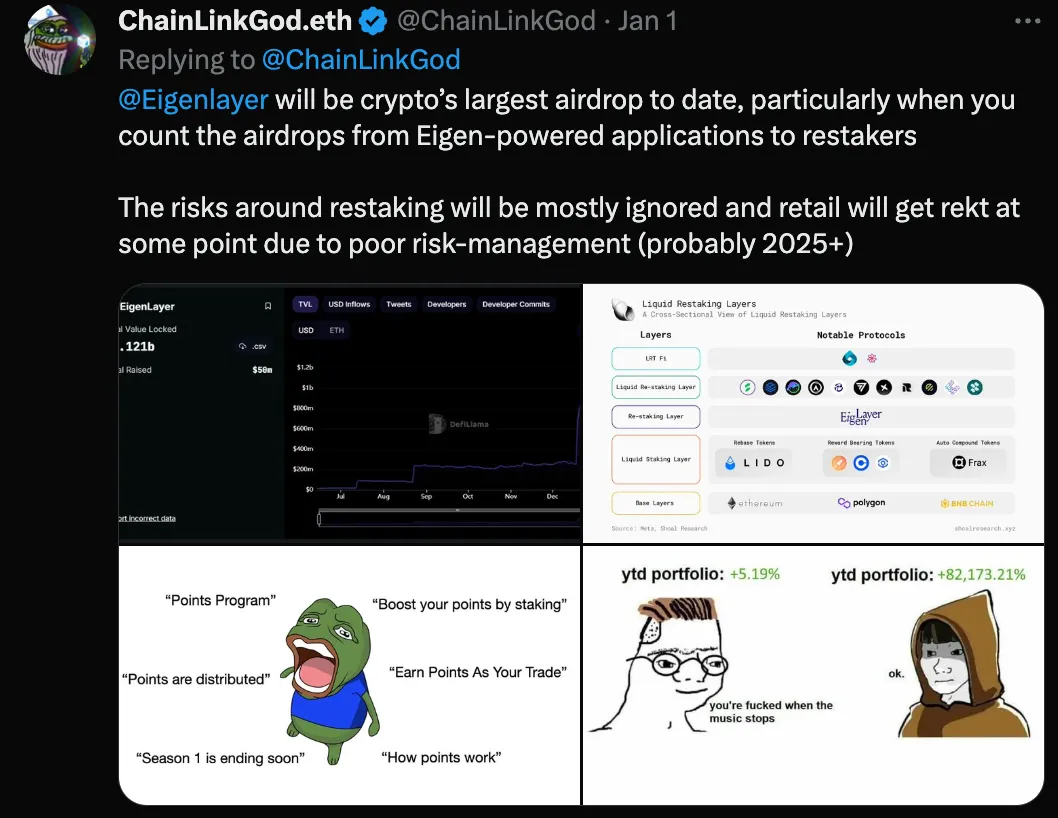
On the current Phase 2 testnet, restakers like you can delegate to operators. These operators verify AVS. Therefore, you are not staking directly to AVS!
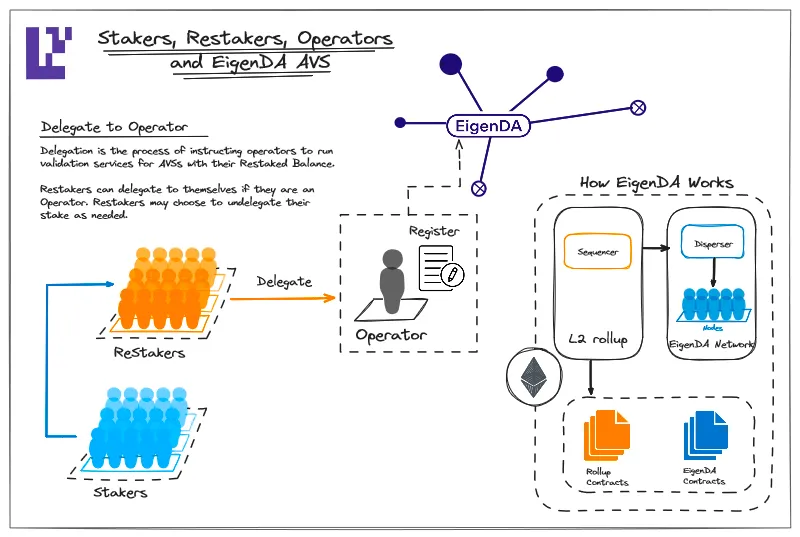
EigenDA (Data Availability) is the first AVS of the second phase. Rollup can be integrated to increase throughput. The second phase of the mainnet will be launched in the first half of 2024, and the third phase will be launched later in 2024 with more AVS.
You can actually see how operator delegation works on the Goerli testnet. according toGuide hereGet some goerliETH and exchange it for stETH. then go to Eigenlayer testnetpage and deposit stETH. Then select the operator running EigenDA AVS.
Interestingly, among the many operators, one stands out: Deutsche Telekom. Telekom appears to be using Eigenlayer for its staking service.
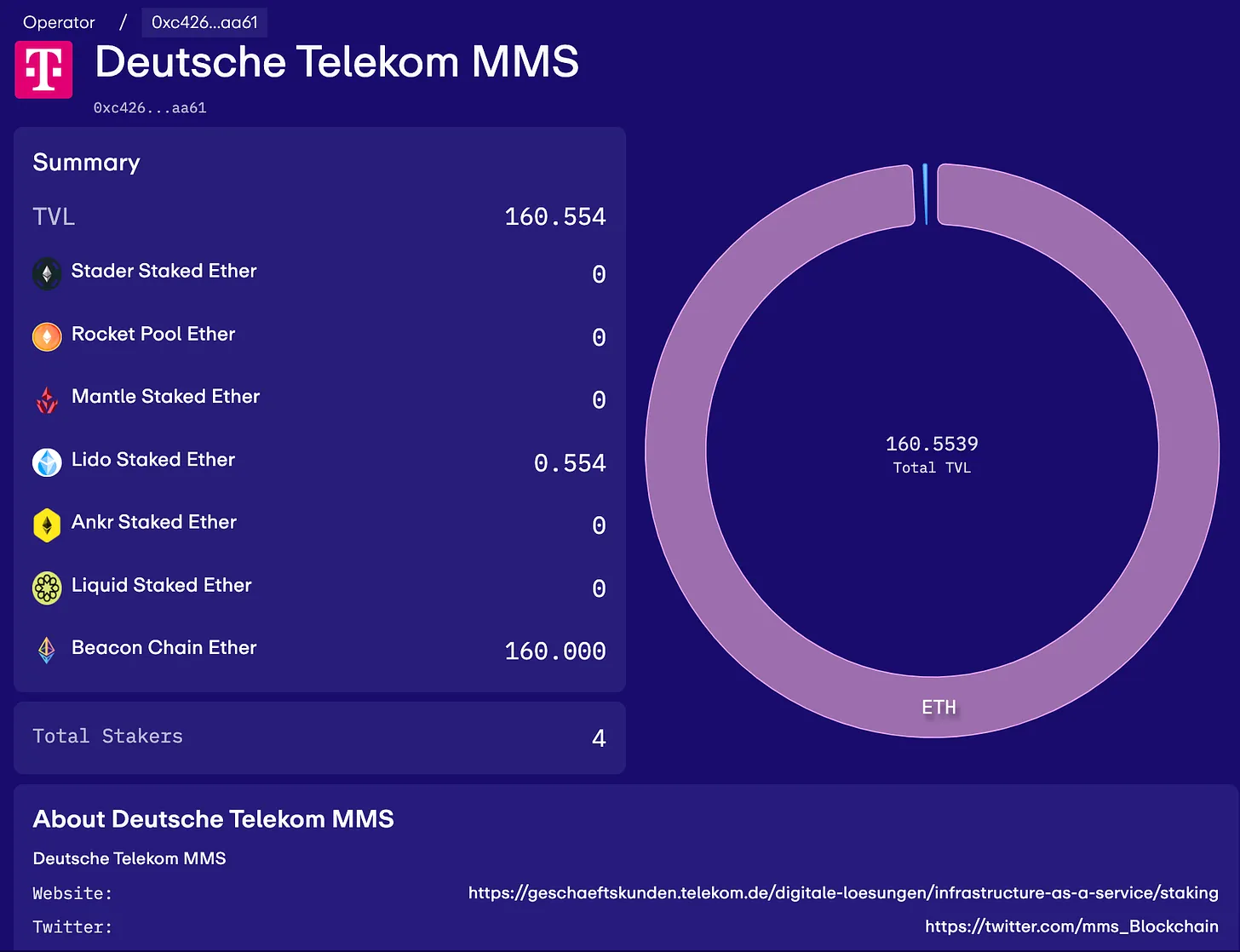
Anyway, are you ready to manually select AVS and operators on mainnet yourself? Considering the high gas costs? And then collect rewards from AVS? Then sell the rewards to get more ETH to compound? If you're not particularly wealthy, you'll think the gas charges here will be high.
I’m sure you can guess what I’m going to say next: Liquidity Recollateralized Tokens (LRT). But more about LRT will be discussed in the next article. Now, let’s focus on the use cases of the new tokens that AVS will airdrop to us.
The first AVS is EigenDA, but I won't go into details as I doubt it will have a separate token (it's a data availability layer for rollup to save on data storage fees).
Active verification service
Don't be fooled by the name. AVS is a fully functional protocol that uses re-staking ETH to enhance its functionality. I mentioned the "insurance bridge" above, but the scope and impact of AVS will soon become more apparent.
I will introduce 7 AVS in very simple language in this blog. Because if we invest ETH into the Restake ecosystem, we need to understand AVS.
Ethos: Bringing ETH safely to the Cosmos
Ethos brings the economic security and liquidity of Ethereum to the Cosmos.
So-called Cosmos Consumer chains typically issue their native staking tokens to secure the network. However, this introduces more complexity and inflationary token economics. While Cosmos ATOM stakers provide an inter-chain security (ICS) solution, the Ethereum ecosystem, through Ethos and re-staking, is now expanding into Cosmos’ own realm.
Coupled with Dymension, the ATOM fork, and now the launch of Ethos, ATOM seems to be under a lot of pressure.
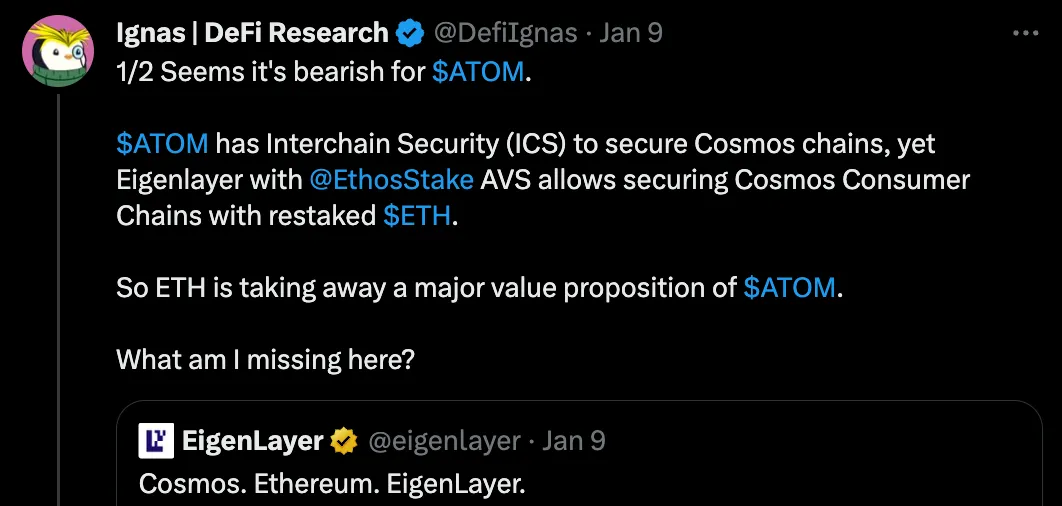
Ethos is inspired by Mesh Security (which allows staked tokens from one chain to be used on another chain), thereby enhancing economic security without the need for additional nodes.For more details please click here to view the Ethos blog post.
Which security solution wins depends on its adoption. Ethos is launching with momentum.
The first partner is Sommelier, an automated revenue library provider with a TVL of $60 million. As far as I know, more Consumer Chains are coming soon.
The advantage of this structure is that ETHOS may receive airdrops (and revenue) of partner chain tokens. At the same time, the ETHOS tokens themselves will be airdropped to ETH re-stakeholders on Eigenlayer as part of our harvest of EIGEN tokens.
All you need to do is stake ETH again and receive the airdrop.
AltLayer: Rollup of re-pledge
I just introduced AltLayer in a previous article, so I won't go too deep into its functionality in this article.You can click here to view it.
But what you need to know is that AltLayer introduces three AVS to bring Rollup
-
Quick finality
-
Decentralized sorting
-
Decentralized verification
The ALT token economic model is interesting because ALT must be staked with re-staking ETH to protect these three AVS.
If you have experienced the 2020 DeFi Summer, you will understand the Ponzi effect it may have.
at present,CommunityOnly 3%’s total supply has been airdropped, but more airdrops are planned in the future. The initial circulating supply is 11%. Does $4.3 billion in FDV (at the time of writing) justify a deal that no one had heard of just a few weeks ago?
Not so sure, but it makes me more bullish on the entire restaking ecosystem.
Additionally, I suspect AltLayer reserves liquidity mining rewards for restakers. As more AVS are launched, various services will compete to attract valuable ETH deposits. After all, AVS without any deposited ETH is worthless.
Espresso: a decentralized sorter
Espresso is a Layer 2 decentralized sorter. as you know,L2Sorters get a lot of flack for being centralized. There’s a nice visual representation of how Espresso leverages its HotShot consensus to achieve this,Please click here to go to their website to view.
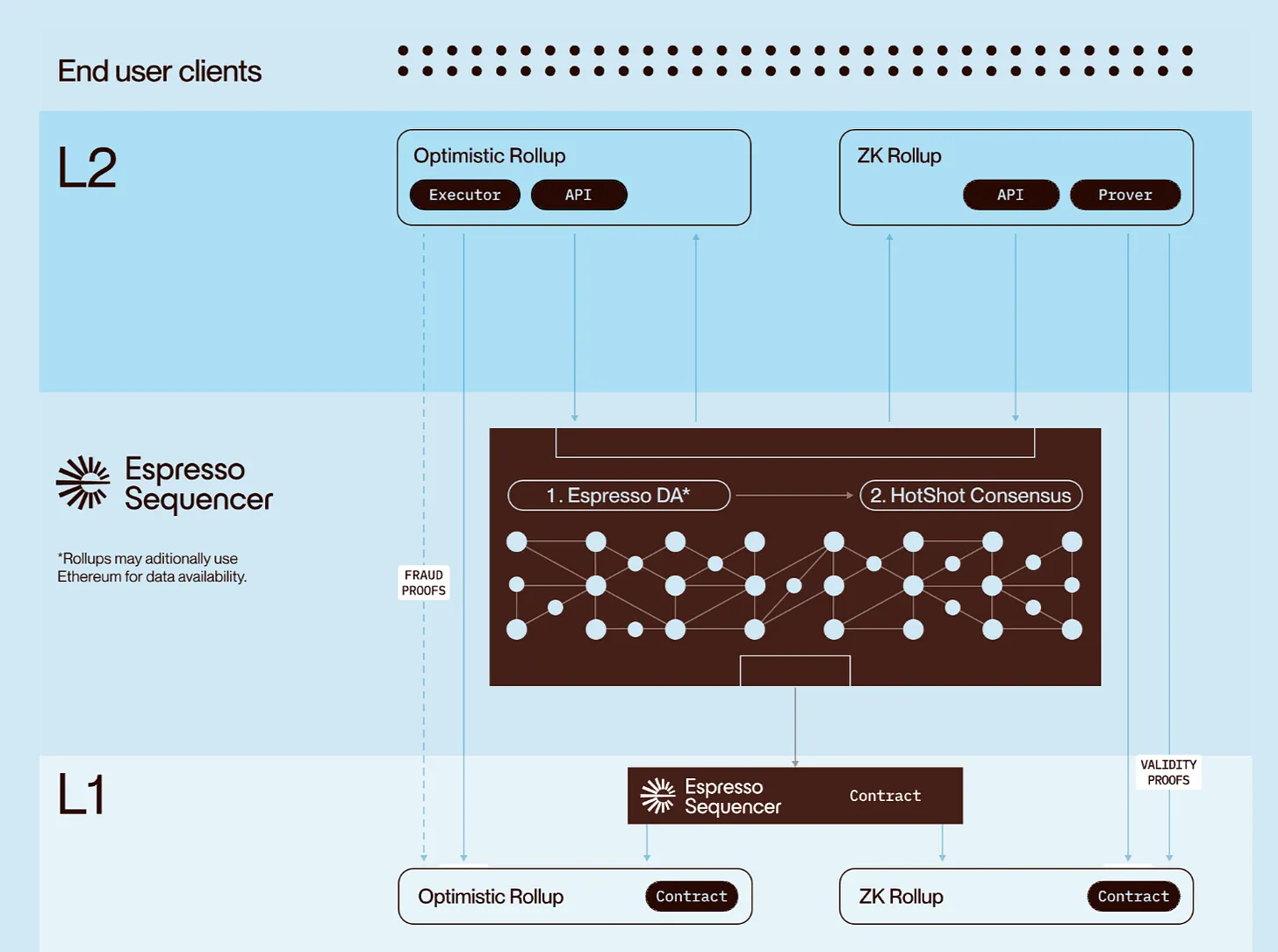
AltLayer actually integrates with Espresso, so developers can choose to use AltLayer's decentralized validation solution and/or the Espresso sequencer to deploy on the AltLayer stack.
Omni: Connect all RollupsBlockchain
question:L2Reduces transaction costs, but leads to fragmentation of the ecosystem. This makes it difficult for developers to reach a wide audience, complicates the user experience, and fragments mobility.
Bridging has also become necessary, but bridging usually issues wrapped tokens, which is risky. If the bridge is hacked, there won’t be enough underlying assets to support the bridge’s wrapped tokens. As a result, the wrapped token loses its peg.
solution:Omni
Omni is a “L1 protected by re-staking”Blockchain”, aiming to unify all rollups of Ethereum under one roof.
Omni introduces a “unified global state layer” that is secured through EigenLayer re-staking. This layer centralizes cross-domain management of applications under one roof.
Use cases include:
-
Cross rollup margin accounts and leverage trading: post margin on one domain and use that margin to trade on another domain
-
Cross rollup NFT minting
-
Cross-rollup lending: deposit collateral on one domain and borrow collateral on another domain
There's a lot more, but does this sound familiar? This is what LayerZero does.
LayerZero’s cross-chain messaging enables Omnichain fungible tokens (OFTs) instead of wrapper tokens. Manta's STONE token is an ETH OFT, and LayerZero issued Lido's wstETH OFT.
But what if there is a vulnerability in the LayerZero messaging system? Well, Omni secures it with staked ETH that will be forfeited if a validator misbehaves.
Consider a frequently speculating degen who wants to use his ETH on Arbitrum to obtain a USDC loan on Optimism. Degen’s transactions on Arbitrum are monitored by Omni validators, who ensure the integrity of data transferred to Optimism. These validators are incentivized by rewards and deterred by the risk of losing their staked ETH due to false reports.
LayerZero可能会使用他们的代币质押来保护跨消息传递安全,但如果LayerZero合约出现问题,代币就会下跌,那种安全性就没有用了。ETH 是系统外部更难保护网络的资产。
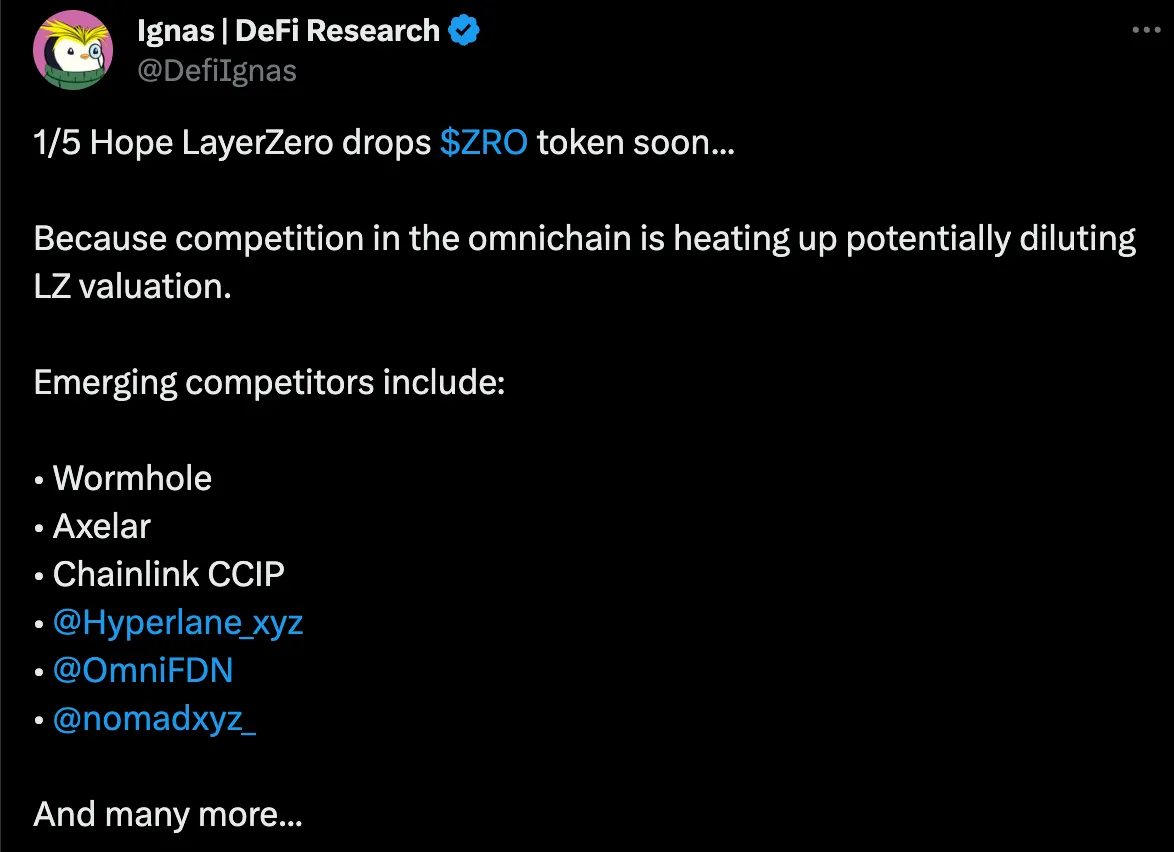
Competition is heating up for LayerZero
Injective partners with Omni to make $INJ the first asset on the Omni open liquidity network. Omni issues xERC20 INJ tokens, bringing INJ into the Ethereum rollup ecosystem.
Omni is backed by $18 million from high-profile investors such as Pantera Capital, Two Sigma Ventures, and Jump Crypto. So, I guess it will do well.
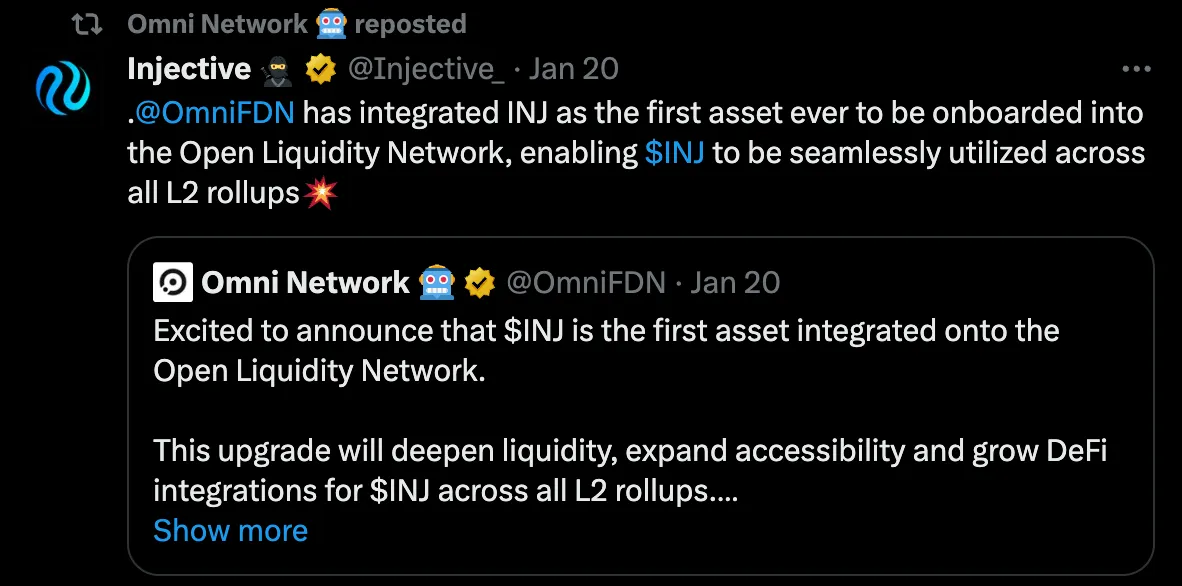
Hyperlane: Similar to Omni, but seems better
Do you think Omni is great at connecting Ethereum Rollup? But HyperlaneXiaobai NavigationSeems more awesome. Because the goal of Hyperlane is to connect all L1 and L2.
Using Hyperlane, developers can build cross-chain applications that span multipleBlockchainThe application, which uses cross-chain messaging, is secured through its modular security stack, which includes cross-chain security modules and re-staking ETH.
Judging from the documentation, Hyperlane will support Ethereum L2, Cosmos ecosystem chain, Solana, Move-based chains, etc.
Hyperlane’s permissionless interoperability sets it apart, as Rollup can connect to Hyperlane itself without the need for cumbersome governance approvals and more. They're very proud of it, as you can see from the tweet below. However, LayerZero v2 also appears to allow permissionless deployment.
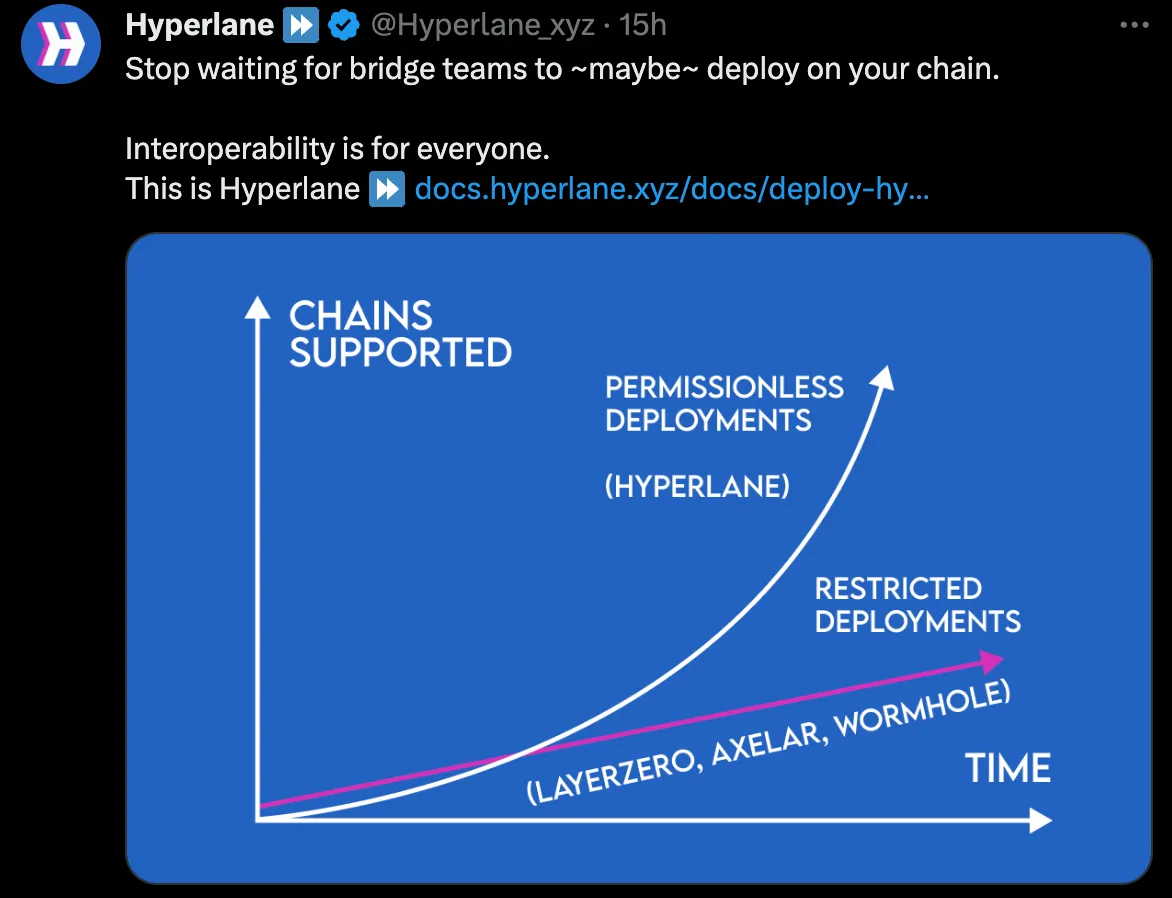
Unfortunately, I can't find token information for Omni or Hyperlane at this time.
The Blockless: Powering dApps as they are used
In ordinary dApps, we cannot directly contribute computing power, and applications are limited by specific L1 or L2 capabilities, such as latency, transaction speed, gas fees, etc.
Therefore, Blockless adopts Net Neutrality Applications (nnApp), allowing users to power applications simply by using them. It uses "nestled nodes" where each user's device acts as a node, contributing its resources to the network. This means that an application's computing power scales as its user base grows, a significant shift from the traditional model.
In short, you run a node while using your application.
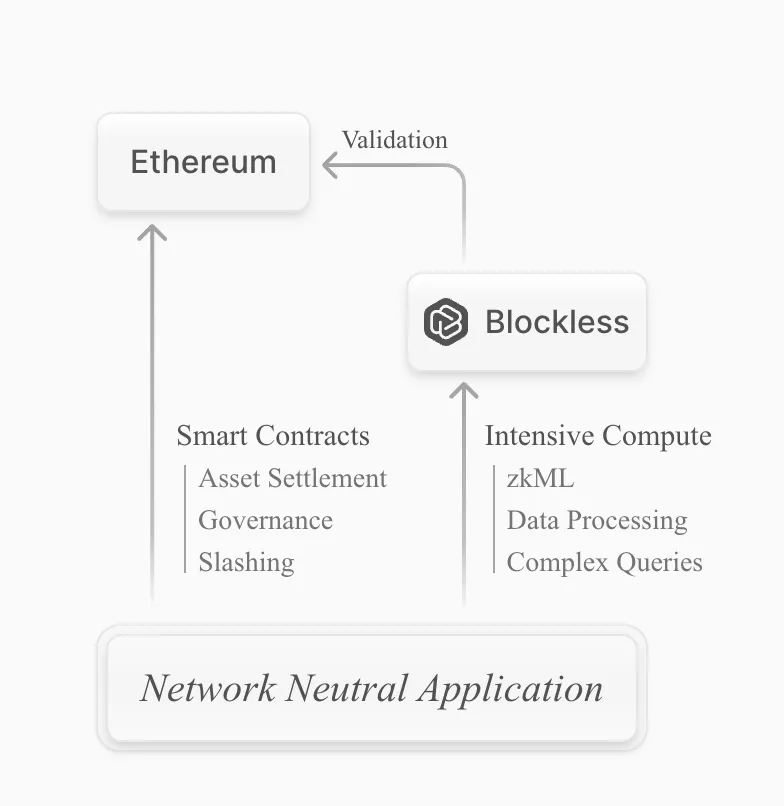
Blockless landing page
For example, some dApps may choose to keep governance on Ethereum and data availability workloads on Celestia or EigenLayer. But computationally intensive work for use cases such as machine learning, AI interfaces, and gaming will be performed in a faster and more efficient off-chain environment.
这导致这些应用程序的计算支持直接随着用户数量的增长而扩展,更多的用户意味着更多社区提供的计算能力。
This reminds me Grass, an app on Solana that sells idle internet bandwidth to train artificial intelligence, although it's not part of Blockless.
Blockless uses proof-of-stake to secure its network, so the token is more than just a meme.
As for re-staking, Blockless will make its network available to applications built on EigenLayer to minimize unexpected cuts.
other
You can view a complete list of all AVS on the Eigenlayer website. It is worth mentioning that:
-
Lagrange : Another competitor to LayerZero, Omni, and Hyperlane, its cross-chain infrastructure is capable of creating universal proof of state across all major blockchains. It recently raised $4 million in seed funding from 1kx and others.
-
Drosera: "Incident response protocol", used to control vulnerabilities. When a hack occurs, Drosera's trap detects it and takes action to mitigate the attack.
-
Witness Chain: Use re-staking to perform Proof of Diligence and ensure the security of rollup, and use Proof of Location to establish physical node decentralization.
The article comes from the Internet:Taking stock of 9 Eigenlayer AVS services, who will become the next Altlayer?
Related recommendations: The bull market has arrived, these 10 trends you need to focus on
zk Rollup, Rollup middleware, interoperability, Bitcoin ecology... Written by: Layergg Compiled by: Luffy, Foresight News The horn of the bull market has sounded, and 2024 is coming. Which tracks and projects do we need to pay attention to? Listed below are 10 trends and projects to watch out for next year…